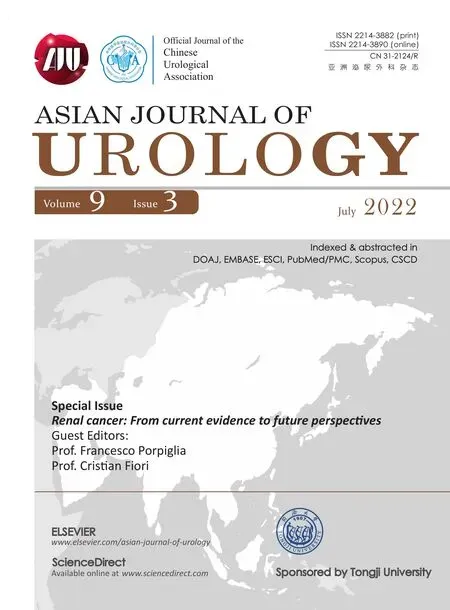Manuscript Guide for Authors
Please visit http://www.ajurology.com for the detailed version of Manuscript Guide.
Scope
Asian Journal of Urology(AJU) focuses on all specialties of urology both scientifi cally and clinically (including, but not limited to, surgical oncology, endourology, calculi, female urology, erectile dysfunction, pediatrics, renal transplantation, reconstructive surgery, infertility, radiology, pathology, and neurourology).
Types of paper
Contributions falling into the following categories will be considered for publication: Editorial, Perspective, Review and Mini-Review, Original Article, Clinical Experience, Clinical Image, Urological data, Case Report, Letter, etc.In addition, Research Highlight, Commentary, and Opinion articles are invited only at present.
AJUwould also like to draw your special attention to the feature column Asian Focus, which welcomes epidemiological, genetic and regional papers, as well as occupational, clinical or health policy studies from Asian countries and regions.For Asian Focus, we prefer for the name of the country or region to be included in the title.Manuscripts for Asian Focus can include any of the article types mentioned above.
Ethical requirement
All materials must adhere to high ethical and animal welfare standards.Any use of animals must be based on ethological knowledge and respect for species-specifi c requirements for health and well-being.For investigations of human subjects, an appropriate institutional review board approved the project and the informed consent was obtained from the study participants.
Conflicts of interest
All authors are requested to disclose any actual or potential confl icts of interest that could inappropriately infl uence, or be perceived to infl uence, their work.
Copyright
Upon acceptance of an article, authors will be asked to complete a “License to Publish”.Acceptance of the license will ensure the widest possible dissemination of information.
Submission
Via the homepage of this journal (http://www.ajurology.com) you will be guided stepwise through the creation and uploading of the various fi les.The fi rst thing you need to do, if you have not done so already, is register for an account on our online submission and review system with ScholarOneTMManuscript Central (http://mc03.manuscriptcentral.com/aju).
Manuscript status
Upon receipt of the manuscript, the editorial offi ce will immediately assign a manuscript ID, which is strongly recommended for use in subsequent correspondence.A letter acknowledging receipt will be sent to the corresponding author.After being pre-reviewed by the editors, most of the submitted manuscripts will be sent to expert referees for peer-review.
Essential title page information
? Title.Concise and informative.
? Author names and affi liations.Present the authors’ affi liation addresses below the names.Provide the full postal address of each affi liation.
? Corresponding author.Clearly indicate who will handle correspondence.Contact details must be kept up to date by the corresponding author.
Abstract
Reports of original data and meta-analyses should include a structured abstract using the headings as Objective, Methods, Results, and Conclusion.For other major manuscripts, include an unstructured abstract that summarizes the objective, main points, and conclusions of the article.Abstracts are not required for Editorials, Perspectives, and some special features.References should be avoided, but if essential, then cite the author(s) and year(s).
Keywords
Authors are invited to submit keywords associated with their papers.
Article structure
Divide your article into clearly defi ned and numbered sections.Subsections should be numbered 1 (then 1.1, 1.2,...), 2 (then 2.1, 2.2, …), etc.(the abstract is not included in section numbering).Any subsection may be given a brief heading (e.g., 1 Intruduction..., 2 Materials and Methods…, 3 Results…, 4 Discussion…, 5 Conclusion…).
Acknowledgments
Collate acknowledgements in a separate section at the end of the article before the references.List here those individuals who provided help during the research or sources of funding and support.
Artwork
General points
? Make sure you use uniform lettering and sizing of your original artwork.
? Save text in illustrations as “graphics” or enclose the font.
? Only use the following fonts in your illustrations: Arial, Courier, Times, Symbol.
? Number the illustrations according to their sequence in the text.
? Use a logical naming convention for your artwork fi les.
? Provide captions to illustrations separately.
? Produce images near to the desired size of the printed version.
? Submit each fi gure as a separate fi le.
Formats
EPS: Vector drawings.Embed the font or save the text as “graphics”.
TIFF: Color or grayscale photographs (halftones): always use a minimum of 300 dpi.
Tables
Number tables consecutively in accordance with their appearance in the text.Place footnotes to tables below the table body and indicate them with superscript lowercase letters.Avoid vertical rules.Be sparing in the use of tables and ensure that the data presented in tables do not duplicate results described elsewhere in the article.
 Asian Journal of Urology2022年3期
Asian Journal of Urology2022年3期
- Asian Journal of Urology的其它文章
- Burned-out testicular seminoma with retroperitoneal metastasis and contralateral sertoli cell-only syndrome
- Endoscopic management of adolescent closed Cowper’s gland syringocele with holmium:YAG laser
- Transcutaneous dorsal penile nerve stimulation for the treatment of premature ejaculation:A novel technique
- Bilateral calcified Macroplastique? after 12 years
- Culture-positive urinary tract infection following micturating cystourethrogram in children
- A phase II study of neoadjuvant chemotherapy followed by organ preservation in patients with muscle-invasive bladder cancer
